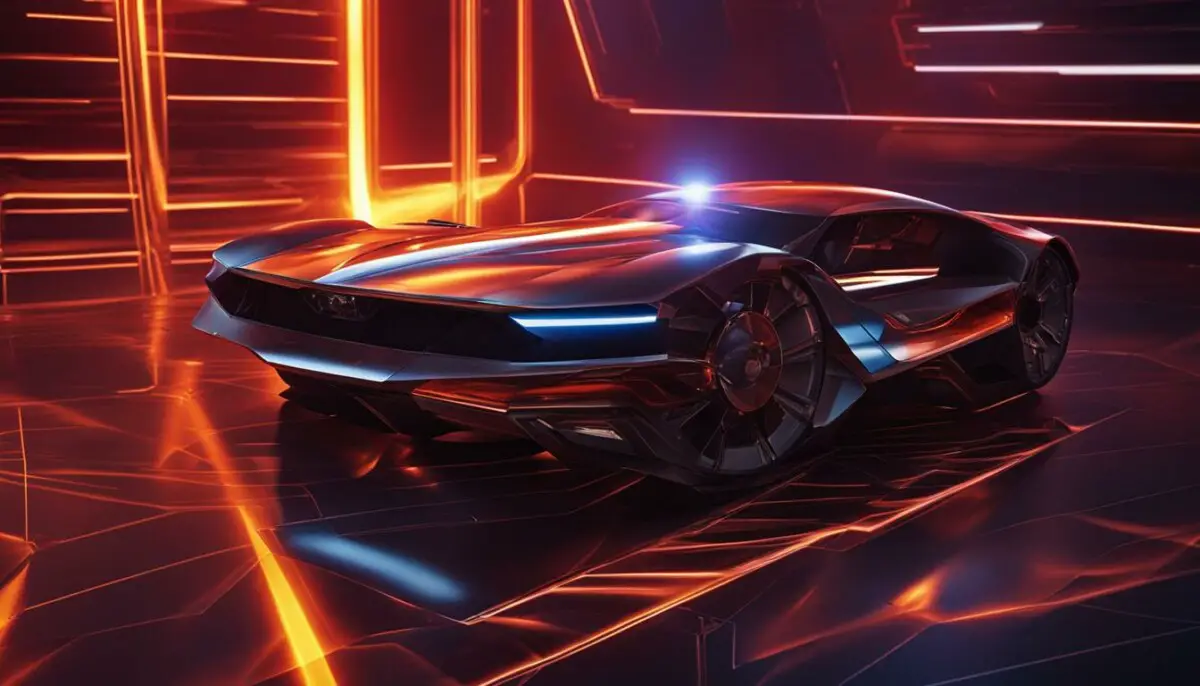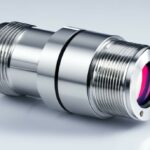Last Updated on 4 months by Francis
Researchers from Seoul, South Korea have made a groundbreaking discovery – the ability to transmit electricity wirelessly through thin air using infrared laser light. This innovation, called distributed laser charging, has the potential to revolutionize the way we transmit electricity, opening up possibilities for wirelessly powering devices and sensors without the need for power cables. Let’s dive into the science behind this fascinating technology and explore its potential applications.
Contents
Key Takeaways:
- Researchers have developed a method to transmit electricity wirelessly through infrared laser light.
- Infrared lasers work by exciting the electrons in optical materials, such as glass or crystal, to create a powerful beam of light.
- This technology could be used to wirelessly power devices and sensors, eliminating the need for power cables.
- Infrared laser charging offers high-power illumination, safe operation, and convenient integration into electrical circuits.
- Ongoing research aims to optimize and expand the capabilities of infrared laser charging and its potential applications.
The Science behind Infrared Laser Charging
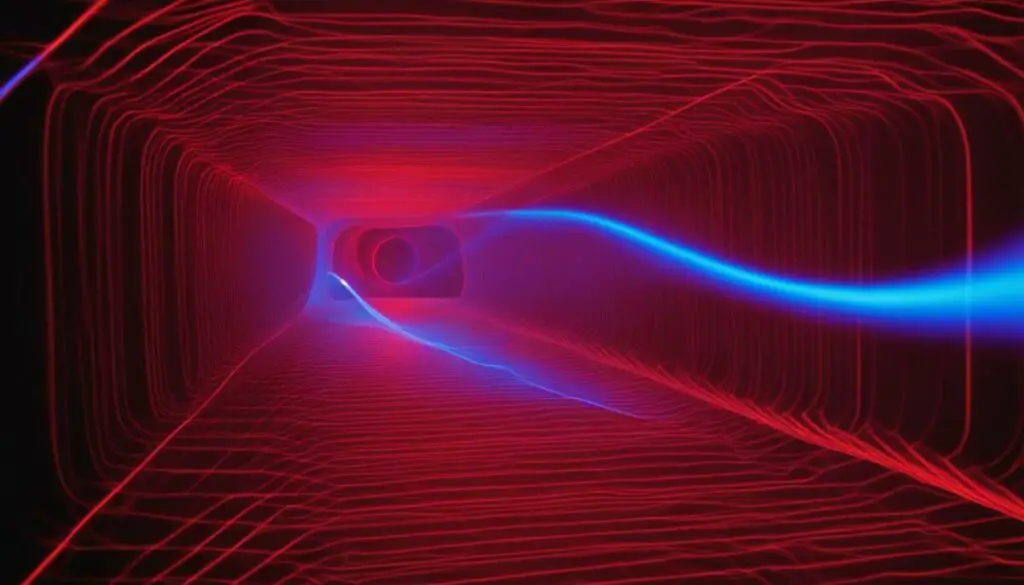
To understand how electricity can travel through an infrared laser, it’s important to know the science behind it. Infrared lasers work by exciting the electrons in optical materials, such as glass or crystal. The lasers use an electrical current or light to cause the electrons to move from a lower-energy orbit to a higher-energy orbit around the atom’s nucleus. As the excited electrons drop back down in energy, they release photons of light. These photons are bounced off mirrors, creating a powerful beam of light. In the case of an infrared laser, the wavelength is low enough to be in the safe part of the infrared spectrum, meaning it won’t cause harm to human skin or eyes.
By harnessing this process, researchers have discovered a way to utilize infrared laser technology for the transmission of electricity wirelessly. This breakthrough has the potential to revolutionize the way we power devices and systems, offering a safer and more convenient alternative to traditional power cables.
With infrared lasers, electrons can be excited and photons of light can be generated to create a powerful beam. This beam can be utilized to transmit electrical energy without the need for physical connections. By integrating the principles of electrical conductivity and optical materials, infrared laser charging enables the wireless transmission of electricity.
The science behind infrared laser charging not only provides a fascinating glimpse into the possibilities of electricity transmission, but also highlights the importance of understanding the underlying mechanisms driving this innovative technology.
The Potential Applications of Infrared Laser Charging
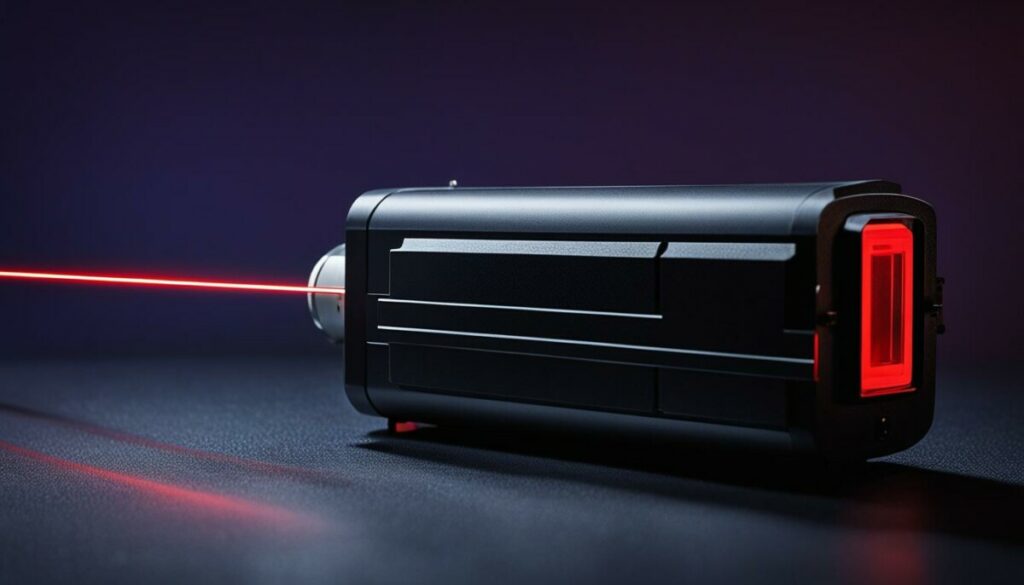
The ability to transmit electricity through an infrared laser opens up a wide range of potential applications. This technology has the potential to revolutionize the way we power our devices and systems. Here are some exciting possibilities:
1. Wireless Powering of Devices
With electrical signals transmitted through infrared laser technology, traditional power cables can be eliminated. Imagine a world where you can charge your smartphone, laptop, or other electronic devices without the hassle of tangled cords. Infrared laser charging offers a convenient and wireless solution for powering various devices.
2. Charging Sensors
Manufacturing plants and other industrial applications rely on sensors for process monitoring. Infrared laser charging can be used to wirelessly charge these sensors, eliminating the need for battery replacements or complicated wiring. This technology streamlines operations and improves efficiency in industrial settings.
3. Integration into Electrical Circuits
The conductivity of electricity in an infrared laser makes it possible to integrate this technology into electrical circuits. This opens up the potential for seamless and efficient power transmission within complex electrical systems. Infrared laser charging can enhance the performance and functionality of various electronic devices and components.
4. Long-Range Electricity Transmission
The long-range capabilities of infrared laser charging make it feasible to transmit electricity over large distances. This is particularly useful in scenarios where traditional power transmission methods are challenging or impractical. Infrared laser technology offers a versatile solution for delivering electricity to remote locations or across expansive areas.
Overall, the potential applications of infrared laser charging are vast. From wirelessly powering devices to integrating this technology into electrical circuits, the conductivity of electricity in an infrared laser opens up new possibilities for efficient and convenient power transmission.
The Advantages of Infrared Laser Charging
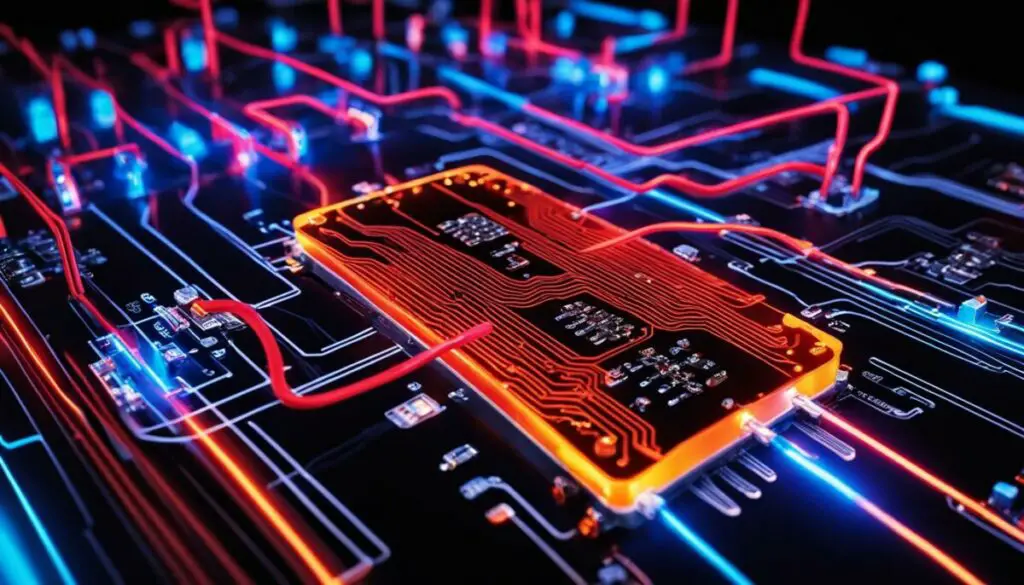
One advantage of infrared laser charging is its ability to provide high-power illumination with minimal light loss. This makes it a highly efficient method of transmitting electricity wirelessly. Additionally, infrared lasers are safe to use, as their wavelength is in the non-harmful part of the infrared spectrum. The ability of infrared lasers to self-align without tracking processes allows for convenient and seamless power transmission. Furthermore, the small size of the receiver unit makes it easy to integrate into devices and sensors.
The Efficiency of Infrared Laser Charging
Compared to traditional methods of electrical conduction, such as wired connections or radiofrequency transmission, infrared laser charging offers several key advantages. One of the major benefits is its high efficiency in power transmission. With minimal light loss, infrared lasers can efficiently and effectively transmit electricity over long distances. This makes it a practical solution for various applications, from powering wireless devices to charging sensors in manufacturing plants.
Moreover, the small size of the receiver unit allows for seamless integration into existing devices and sensors. This means that devices can be easily retrofitted to take advantage of infrared laser charging without major design alterations. The compact receiver unit also ensures a clean and aesthetic appearance, without the need for bulky and cumbersome power cables.
Furthermore, the self-aligning capability of infrared lasers eliminates the need for complex tracking processes. Unlike other wireless power transfer methods that require precise alignment between the transmitter and receiver, infrared laser charging can automatically adjust to maintain optimal power transmission. This makes it a user-friendly solution that doesn’t require constant manual adjustments or alignment checks.
Enhancing Electrical Circuits with Infrared Laser Charging
In addition to its efficiency in power transmission, infrared laser charging also offers new possibilities for enhancing electrical circuits. The conductivity of electricity in an infrared laser allows for the integration of this technology into various electrical systems and circuits. By incorporating infrared laser charging into electrical circuits, devices can be powered wirelessly with no need for physical connections or cables.
| Advantages of Infrared Laser Charging | |
|---|---|
| High-power illumination with minimal light loss | |
| Safe operation with non-harmful infrared spectrum | |
| Seamless integration into devices and sensors | |
| Self-aligning capability for convenient power transmission |
By leveraging the conductivity of electricity in an infrared laser, electrical circuits can be optimized for efficiency and reliability. This opens up new possibilities for advanced automation systems, IoT devices, and smart technologies that rely on wireless power transfer. Infrared laser charging has the potential to revolutionize the way we think about electrical circuits and power distribution.
Overall, the advantages of infrared laser charging make it a promising technology for wireless power transmission and electrical conduction. Its high efficiency, safe operation, seamless integration, and capability to enhance electrical circuits positions it as a viable solution for a wide range of applications.
Challenges and Future Developments in Infrared Laser Charging
Despite the tremendous potential of infrared laser charging, several challenges and opportunities for future development exist in this field. One of the main challenges is maintaining an uninterrupted line of sight between the transmitter and receiver. Since infrared laser charging relies on seamless laser beams, any obstacles in the path can disrupt the power transmission. In such cases, the system automatically switches to a power-safe mode to ensure safety and efficiency.
Another area for improvement is enhancing the efficiency of the photovoltaic cell used in the receiver unit. By improving the conversion of light into electrical power, researchers aim to maximize the output of the charging system. Ongoing research focuses on optimizing and expanding the capabilities of infrared laser charging, with the goal of overcoming current limitations and pushing the boundaries of this technology.
The Challenges of Line of Sight
To achieve successful power transmission, maintaining an uninterrupted line of sight is essential. Any physical obstacles, including walls or objects, can hinder the laser beams from reaching the receiver unit. This poses a challenge, especially in environments where a clear line of sight cannot always be guaranteed. Researchers are actively exploring advanced tracking systems to enhance the reliability of power delivery and minimize interruptions caused by obstacles.
Enhancing Photovoltaic Cell Efficiency
The efficiency of the photovoltaic cell used in the receiver unit plays a crucial role in harnessing the full potential of infrared laser charging. Researchers are dedicated to improving the conversion of light energy into electrical power, aiming for higher efficiency levels. Advancements in materials and design are being explored to optimize the performance of these cells, enabling greater power generation and overall system efficiency.
Future Developments in Infrared Laser Charging
The future of infrared laser charging holds promise for further advancements and applications. Ongoing research and development endeavors focus on optimizing the technology for wider use, such as long-distance power transmission and integration with existing electrical infrastructure. By addressing the current challenges and pushing the boundaries of infrared laser conductivity, researchers aim to harness the full potential of this cutting-edge technology.
| Challenges in Infrared Laser Charging | Future Developments |
|---|---|
| Maintaining uninterrupted line of sight | Advanced tracking systems for obstacle detection and reliable power delivery |
| Enhancing photovoltaic cell efficiency | Optimizing materials and design for higher conversion rates |
| Exploring long-distance power transmission and integration with existing infrastructure |
Real-world Applications of Infrared Laser Charging
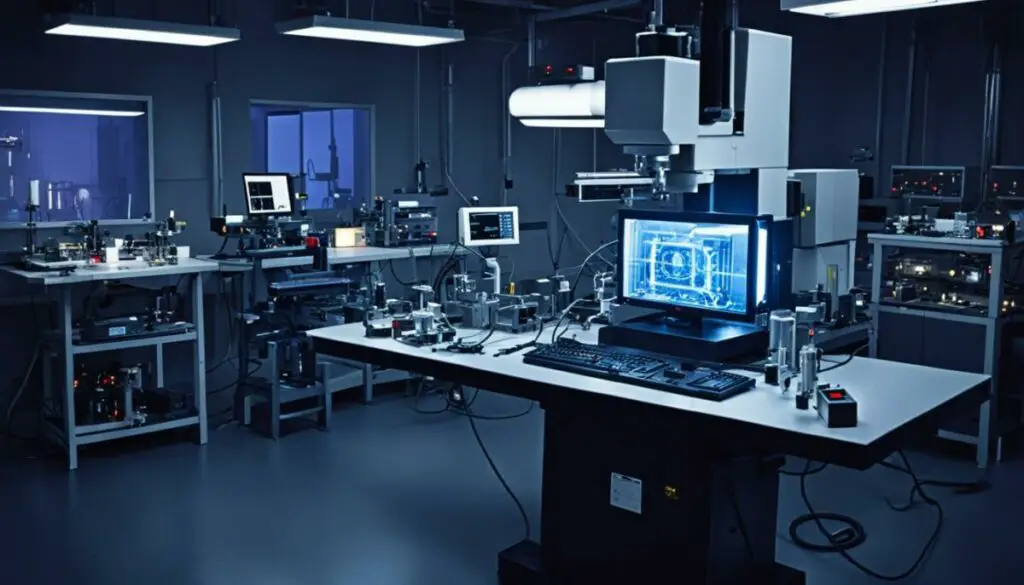
The potential real-world applications of infrared laser charging are vast. One area where it could be beneficial is in factories, where it could replace power cords, saving on maintenance and replacement costs. In harsh environments where electrical connections can cause interference or fire hazards, infrared laser charging could provide a safer alternative. Infrared laser charging also holds promise for charging mobile devices wirelessly, offering convenience and freedom from tangled cords.
| Application | Description |
|---|---|
| Industrial Automation | Infrared laser charging can be integrated into manufacturing processes to wirelessly power sensors and devices, enabling real-time process monitoring and control. |
| Consumer Electronics | Mobile devices, such as smartphones and tablets, can be charged wirelessly using infrared laser technology, eliminating the need for charging cables. |
| Automotive Industry | Infrared laser charging can be utilized to wirelessly charge electric vehicles, reducing the need for charging stations and improving convenience for EV owners. |
| Medical Devices | Infrared laser charging can power implantable medical devices, eliminating the need for frequent surgeries to replace batteries, and improving the overall patient experience. |
Industrial Automation
In the field of industrial automation, infrared laser charging has the potential to revolutionize manufacturing processes. By wirelessly powering sensors and devices, infrared laser charging enables real-time process monitoring and control. This technology can enhance efficiency, reduce downtime, and improve overall productivity in factories.
Consumer Electronics
Consumers are increasingly embracing wireless charging solutions for their electronic devices. Infrared laser charging offers a convenient and tangle-free solution for charging smartphones, tablets, and other portable devices. By eliminating the need for charging cables, this technology simplifies the charging process and enhances user experience.
Automotive Industry
Electric vehicles (EVs) are gaining popularity as a sustainable transportation option. Infrared laser charging can play a crucial role in the widespread adoption of EVs by offering wireless charging capabilities. This technology allows EV owners to charge their vehicles without the need for dedicated charging stations, increasing the convenience and flexibility of electric transportation.
Medical Devices
The medical field can greatly benefit from infrared laser charging technology. Implantable medical devices, such as pacemakers and neurostimulators, often require frequent surgeries to replace their batteries. By wirelessly charging these devices using infrared lasers, the need for invasive surgeries can be significantly reduced, improving patient comfort and reducing healthcare costs.
The Future of Infrared Laser Charging Technology

As technology continues to advance, the future of infrared laser charging holds great promise. Researchers are dedicated to enhancing the efficiency and range of power transmission, pushing the boundaries of electrical signals through infrared laser.
The advancements in infrared laser conductivity have the potential to revolutionize various aspects of our lives. This technology opens up new possibilities for powering everyday devices and infrastructure without the need for traditional power cables.
With ongoing research and development, the integration of infrared laser charging into our devices and systems could lead to groundbreaking advancements in electrical connectivity. Imagine a future where wireless power transmission is not only convenient but also sustainable and efficient.
The Advancements in Infrared Laser Charging Technology
Researchers are focusing on the following areas of advancement in infrared laser charging technology:
- Increasing the efficiency of power transmission
- Expanding the range of infrared laser conductivity
- Optimizing the integration of infrared laser charging into everyday devices
By addressing these areas, the potential for infrared laser charging to become a mainstream method of electrical conduction is becoming more tangible every day. Our future is brighter with the possibilities offered by this revolutionary technology.
“The integration of infrared laser charging into everyday devices and infrastructure could revolutionize the way we power our world.”
| Advantages | Challenges | Potential Applications |
|---|---|---|
| High-power illumination with minimal light loss | Maintaining a reliable line of sight between the transmitter and receiver | Wirelessly powering devices and sensors |
| Safe operation with non-harmful infrared laser wavelength | Increasing the efficiency of the photovoltaic cells | Charging sensors in manufacturing plants |
| Convenient and seamless power transmission | Ongoing research to optimize and expand capabilities | Integration into electrical circuits |
As we look towards the future, the possibilities of infrared laser charging are truly exciting. With continued advancements and research, we are on the verge of a new era of electrical conduction.
The Safety of Infrared Laser Charging
Safety is a crucial aspect of any technology, including infrared laser charging. Fortunately, infrared lasers operate in a wavelength range that is safe for human skin and eyes. The power levels used in infrared laser charging are carefully controlled to ensure there is no risk of harm. Additionally, the system automatically switches to a power-safe mode when the line of sight is blocked. This ensures that even in the presence of obstacles, the technology remains safe to use.
With the use of infrared lasers in electricity transmission via infrared laser, there are concerns about the potential risks involved. However, extensive research and safety measures have been implemented to address these concerns. The wavelength range of infrared lasers falls within the non-harmful part of the infrared spectrum, minimizing any risk to human health.
Furthermore, the power levels in infrared laser charging are highly regulated to prevent any harm. Special safety protocols are in place to ensure that the power delivered is within safe limits and poses no danger to users. In the event that the line of sight between the transmitter and receiver is blocked, the system automatically switches to a power-safe mode, ceasing the transmission of electricity. This feature further enhances the safety of infrared laser charging.
The safety of infrared laser charging technology has been thoroughly tested and validated. Stringent safety standards and guidelines have been established to ensure the safe implementation and usage of this technology. As a result, users can have confidence in the safety of infrared laser charging for various applications, including electricity transmission via infrared laser and integration into electrical circuits.
The Impact of Infrared Laser Charging on Energy Efficiency
Infrared laser charging has the potential to revolutionize energy efficiency by enabling wireless transmission of electricity. This groundbreaking technology eliminates the need for traditional power cables, reducing energy losses associated with cable transmission and minimizing the materials and resources required for cable infrastructure.
By harnessing the power of infrared lasers, electricity can be transmitted wirelessly, offering a more sustainable and efficient energy future. The application of infrared laser charging has far-reaching implications across various industries and sectors, providing a viable solution to enhance energy efficiency.
Advantages of Infrared Laser Charging
The advantages of infrared laser charging extend beyond the elimination of power cables. This innovative technology offers several benefits:
- Reduced energy losses: Traditional power transmission through cables is associated with energy losses due to resistance. Infrared laser charging mitigates this issue, resulting in higher energy efficiency.
- Cost and resource savings: With the elimination of power cables, there is a reduction in the materials and resources required for cable infrastructure, leading to cost savings and environmental benefits.
- Flexibility and convenience: Wireless transmission of electricity provides flexibility in the placement and movement of devices, offering convenience and eliminating the need for physical connections.
Realizing Energy Efficiency with Infrared Laser Charging
| Industry/Application | Impact of Infrared Laser Charging |
|---|---|
| Smart Homes | Enables wireless charging of smart devices and appliances, reducing the clutter of power cords and improving energy efficiency. |
| Manufacturing | Wirelessly powers sensors and devices in manufacturing plants, reducing maintenance costs and streamlining operations. |
| Transportation | Offers a wireless charging solution for electric vehicles, allowing for convenient recharging without the need for physical connections. |
| Healthcare | Enables wireless charging of medical devices, reducing the need for frequent battery replacements and improving patient care. |
The Future of Energy Efficiency
As technology continues to advance, infrared laser charging holds tremendous potential for transforming energy efficiency across various sectors. Ongoing research and development efforts aim to enhance the capabilities and efficiency of infrared laser charging systems, paving the way for a cleaner, greener, and more sustainable future.
Overcoming Obstacles in Infrared Laser Charging
Although infrared laser charging offers numerous advantages, there are still challenges that need to be addressed in order to maximize its potential. Two key obstacles that researchers are currently focusing on are maintaining a reliable line of sight between the transmitter and receiver and optimizing the efficiency of the photovoltaic cell in the receiver unit.
To ensure uninterrupted power transmission, maintaining a clear line of sight between the transmitter and receiver is essential. However, in certain environments, this can be challenging due to obstacles such as walls or objects blocking the laser beams. Advanced tracking systems are being developed to address this obstacle, allowing for real-time adjustment and alignment of the laser beams to ensure consistent and reliable power transmission.
Another crucial aspect for maximizing the amount of electrical power generated is optimizing the efficiency of the photovoltaic cell in the receiver unit. The photovoltaic cell is responsible for converting the received laser energy into electrical power. Ongoing research aims to enhance the efficiency of the cell, enabling it to capture and convert a greater percentage of the incoming energy into usable electrical power.
By overcoming these obstacles, researchers and engineers are working towards perfecting the infrared laser charging technology and unlocking its full potential in various applications.
Development of Advanced Tracking Systems
“Advanced tracking systems are being developed to address the challenge of maintaining a clear line of sight between the transmitter and receiver in infrared laser charging. These systems employ innovative algorithms and sensors that continuously monitor and adjust the position and orientation of the laser beams, ensuring consistent and uninterrupted power transmission.”
Optimization of Photovoltaic Cell Efficiency
“Efforts are underway to optimize the efficiency of the photovoltaic cell in the receiver unit of infrared laser charging systems. By leveraging new materials, designs, and manufacturing techniques, researchers are working to improve the cell’s ability to convert the received laser energy into usable electrical power, maximizing the overall system efficiency.”
| Obstacle | Solution |
|---|---|
| Maintaining line of sight between transmitter and receiver | Development of advanced tracking systems |
| Optimizing photovoltaic cell efficiency | Research and development of improved cell designs |
Conclusion
In conclusion, the utilization of infrared laser technology for transmitting electricity holds immense potential in the field of wireless power transmission. This groundbreaking innovation offers numerous advantages, including high-power illumination, safe operation, and unparalleled convenience. Although there are challenges to overcome, continuous research and development are paving the way for a future where electricity can be efficiently transmitted wirelessly over long distances. The integration of infrared laser charging into various applications has the potential to revolutionize the way we power our devices and systems.
FAQ
Can electricity travel through an infrared laser?
Yes, electricity can travel through an infrared laser by utilizing the conductivity of electrical signals in the laser. With the use of distributed laser charging, electricity can be transmitted wirelessly through thin air using infrared laser light.
How does infrared laser charging work?
Infrared laser charging works by exciting the electrons in optical materials, such as glass or crystal, using an electrical current or light. The excited electrons release photons of light, which are then bounced off mirrors to create a powerful beam of infrared laser light. This laser light allows for the transmission of electricity through the laser.
What are the potential applications of infrared laser charging?
The potential applications of infrared laser charging are vast. This technology can be used to power devices wirelessly, eliminating the need for power cables. It can also be used to charge sensors, integrate into electrical circuits, and transmit electricity over large distances.
What are the advantages of infrared laser charging?
Infrared laser charging provides high-power illumination with minimal light loss, making it a highly efficient method of transmitting electricity wirelessly. Infrared lasers are safe to use, and their self-aligning nature allows for convenient and seamless power transmission. Additionally, the small size of the receiver unit makes integration into devices and sensors easy.
What are the challenges and future developments in infrared laser charging?
One challenge in infrared laser charging is maintaining a line of sight between the transmitter and receiver, as uninterrupted laser beams are crucial for power transmission. Another area for development is optimizing the efficiency of the photovoltaic cell in the receiver unit to enhance the conversion of light into electrical power.
What are some real-world applications of infrared laser charging?
Infrared laser charging could be beneficial in factories, where it could replace power cords, saving on maintenance and replacement costs. It can also provide a safer alternative to electrical connections in harsh environments. Additionally, it offers wireless charging for mobile devices, eliminating the need for tangled cords.
What does the future hold for infrared laser charging technology?
Ongoing research aims to increase the efficiency and range of power transmission in infrared laser charging. This could lead to more applications and advancements in electrical conductivity via infrared lasers, potentially revolutionizing the way we power our devices and systems.
Is infrared laser charging safe to use?
Yes, infrared lasers used in charging operate in a wavelength range that is safe for human skin and eyes. The power levels are carefully controlled to ensure no risk of harm. The system also automatically switches to a power-safe mode when the line of sight is blocked, ensuring safety even in the presence of obstacles.
How does infrared laser charging impact energy efficiency?
Infrared laser charging contributes to improved energy efficiency by enabling the wireless transmission of electricity, eliminating the energy losses associated with cable transmission. It also reduces the materials and resources required for cable infrastructure, making it a more sustainable and efficient energy solution.
What obstacles exist in infrared laser charging and how can they be overcome?
One obstacle in infrared laser charging is maintaining a reliable line of sight between the transmitter and receiver in certain environments. Researchers are working on developing advanced tracking systems to ensure uninterrupted power transmission. Additionally, optimizing the efficiency of the photovoltaic cell in the receiver unit is crucial for maximizing the amount of electrical power generated.
Can electricity pass through an infrared light?
Yes, electricity can pass through an infrared light when utilizing the conductivity of electrical signals in an infrared laser. This allows for the transmission of electrical power wirelessly, opening up possibilities for wireless charging and power transmission.

